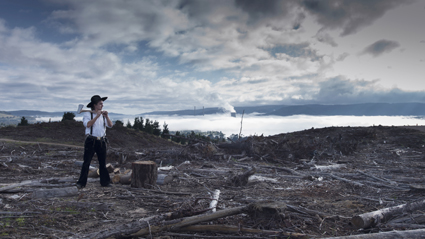lo-fi & hi-fi, irony & alchemy
ella mudie: we need you, you need us, and red water

Nathan Babet (Hrebabetzky), Wood Splitter – 2012 (production still)
photo Josh Raymond
Nathan Babet (Hrebabetzky), Wood Splitter – 2012 (production still)
WE NEED YOU, YOU NEED US—THE TITLE IMPLIES A STICKY SITUATION OF MUTUAL DEPENDENCE. THIS CLEVER AND TOPICAL GROUP SHOW AT TIN SHEDS GALLERY CURATED BY GEORGIE MEAGHER BROUGHT TOGETHER FIVE ARTISTS TO PRESENT A PROVOCATION OF SORTS.
A challenge to consider not only the intertwined relationship between artists, galleries and audiences but also the powerful yet often neglected influence that economic relations exert on the making, exhibiting and consumption of art.
Artists working at the dematerialised end of the art-making spectrum deal increasingly in the trading and transmission of experiences and this show was particularly concerned with how such practices destabilise the notion of value in the economy of art. The 90s business pop-philosophy of the ‘Experience Economy’ was a curatorial starting point for Meagher and if the premise bordered on the prescriptive, most artists responded with a welcome light-hearted approach or applied a deft hand to the theme.
Resonating strongly with audiences was Dara Gill’s Untitled (Depositing $250 Artist Fee into Gallery Wall, 2012) which, as the title neatly describes, involved a video documentation of the performative gesture of the artist drilling a hole into the white gallery wall, carefully rolling and inserting his $250 artist fee into the hole and then filling, sanding and painting over it. It was a cynical yet engaging gesture that lampooned art as a remunerative from of labour and reminded audiences that for many artists the making of a work swallows more funds than it generates.
Sebastian Moody, meanwhile, embraced an all-encompassing form of performance art in The Sting (2012), a work that revolved around Moody’s outsourcing of the day-to-day maintenance of his identity (email, Facebook, internet banking and the like) to a young unemployed Brisbane musician named Maxwell Farrington. In a short video work the pair casually negotiated the ins and outs of their con while the viewer struggled to identify Maxwell from Sebastian, becoming implicated in a game of cat and mouse over who represented the ‘real’ impostor.
Others works tested the premise that audience participation can inject greater agency into the economy of relations between the art object and viewer, with varying results. Paul Gazzola’s Just For The Thrill Of It (2012) comprised a re-purposed Jumbo Skill Tester machine filled with hundreds of brightly coloured key tags inserted with the details of Gazzola’s “company.” By inserting a coin and manoeuvering the mechanical claw into the pile, players could retrieve a tag and earn a share in the company—here the experience of participating in the game was perhaps more novel than empowering. Lara Thoms, on the other hand, introduced an unnerving and stalkeresque edge to audience participation in CONGRATS#2 (2012). Inviting gallery visitors to inscribe their mobile numbers onto the machine’s Bingo card over the duration of the exhibition, whichever number the Bingo ball landed upon on the final day of the show Thoms pledged to call daily for an entire year, a potentially rewarding or rather awkward prize depending upon your point of view.
Agatha Gothe-Snape’s series of de-skilled artworks playfully refuted the notion that either the purity of materials or the precision of an artist’s skill can act as arbiters of an artwork’s value. A whimsical yellow rectangle Power Point slide show reworked Minimalism for the DIY digital age and a series of limited edition prints were dictated by the mileage of a single ink cartridge inserted into a bubble jet printer. Gothe-Snape’s works were typical of the wryly ironic, self-reflexive and low-fi contributions of the five artists which presented a diverse and stimulating range of interpretations on the theme, provoking responses that were albeit more cerebral than visceral.
There was a welcome contrast, then, in Nathan Babet’s unrelated installation Red Water (?ervená Voda) in the next room which presented a multimedia environment spilling over with signification and affective power as Babet, an artist working with sculpture and video, continued his investigation into the loaded terrain of the uncanny. Here, Babet inhabited the figure of the Zimmerman (carpenter) and filled the gallery with the products of his labour, from piles of chopped wood, ceiling height pine trees and a lone felled tree to an imposing Gulag watchtower. Two video loops showed the artist-carpenter taking slow and menacing trance-like swings at a tree with his axe and chopping wood in a hauntingly barren and smoky industrial landscape. The exhilarating intensity of Babet’s labour and the array of evocative and resonate objects installed in the space was a powerful reminder of the value that resides in alchemical artworks which seek to transport, affect and move the viewer.
We Need You, You Need Us, artists Paul Gazzola, Dara Gill, Agatha Gothe-Snape, Sebastian Moody, Lara Thoms; Red Water, artist Nathan Babet, Tin Sheds Gallery, Sydney, April 20–May 19
RealTime issue #110 Aug-Sept 2012 pg. 53






